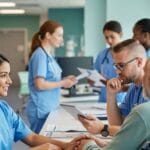
Jay Walker, Curator of TEDMED closed the 2012 meeting by saying there were three I’s that sum up what
TEDMED is all about:

Jay Walker, Curator of TEDMED closed the 2012 meeting by saying there were three I’s that sum up what
TEDMED is all about:
- Innovation
- Imagination
- Inspiration
I would like to add a third I – and that is for icons. There were a lot of accomplished and prominent people on the stage during the three and a half days of the TEDMED 2012 event, but two of them rose to the level of icons.
The first icon to grace the stage was E.O. Wilson (the E.O. is for Eugene Osborne). E.O., Honorary Curator in Entomology and University Research and Professor Emeritus at Harvard University, is hailed in our conference booklet as “one of the leading biologists in the world and one of the foremost naturalists in both science and literature.” He is a synthesizer – as all great eclectic thinkers are – and he is an innovator – having created “two scientific disciplines (island biogeography and sociobiology), three unifying concepts for science and the humanities (biophilia, biodiversity studies, and consilience) and one major technological advance in the study of global biodiversity (the Encyclopedia of Life).”
Most of the speakers at TEDMED, even the researchers and doctors, were entertainers, using eye-popping visuals and stage-worthy voice modulation and arm gestures – most, I suspect put hours and hours into perfecting their presentations so that they would look really, really good when their TEDMED videos go viral. But not E.O. (I hope he doesn’t mind that I call him that). E.O. read his talk from notes typed in a very large font (I was in the front row so I could see these details). And, he did so without dramatic flourish. In fact, you had to listen very intently to hear what he had to say.
His talk was based on a book he is writing for young scientists – telling them why science is so important and why they should not be discouraged from entering the field because they don’t get mathematics. He had many words of wisdom, such as “stay distant from the fray, but instead, create a fray of your own” and “think like a poet, but work like a bookkeeper.” Don’t worry that you don’t know, like, care about math, he told the audience, you can learn it later in your career when you need know it. He didn’t take calculus until he was a 36 year old professor at Harvard. Then, when he wanted to learn it, he had to take a class with youngsters half his age. It didn’t matter, he says, you need to keep on learning and doing and above all using your imagination. He got a standing ovation that went on for a long time. I learned later that even the staff behind the stage, usually a raucous bunch, was completely silent the whole time E.O. was on stage. An icon.
The other icon that rocked the TEDMED audience was Billy Jean King. That’s right, the tennis player. She was interviewed by Katie Couric, no slouch in the icon department herself. First, we were shown a video that took us through the highlights of King’s long and distinguished sports career, highlighted of course, by her win over Bobby Riggs, an event hailed by many women “of a certain generation” as a game changer in the “Women’s Lib” movement. And, it was. Billy Jean not only beat the guy, but she went on to form the Women’s Tennis Association and lead the fight to have women’s tennis recognized as a sporting event worthy of pay as good as men’s tennis. And, she didn’t stop there. She also advocated for gay rights. Billy Jean’s advocacy, she told us wasn’t just about women, but about equality.
Of course, the conversation between King and Couric included a discussion of Title IX, the ground breaking legislation that changed the world for women. It is because of Title IX, Women’s Lib, and people like Billy Jean King that I got to go to medical school. Just a few years before, my college counselor told me to forget med school, women don’t get in, “you should become a medical technician instead.”
For all you young women (and men) out there who feel you have to denigrate or distance yourselves from Women’s Lib Movement and feminism, I urge you to learn the history. Just as the contemporaneous Civil Rights movement opened doors for African Americans previously barred from so many activities that we now accept as commonplace (such as eating at the same restaurants, drinking from the same water fountains, and attending the same schools as whites), the Women’s Movement made it possible for women to play competitive sports, attend medical school, and, become fighter pilots. Billy Jean is an Icon.
A few other highlights from days 3 and 4 of TEDMED include Jay Walker sharing his rare book collection with us. One was the 17th century Book of Mortality. Jay gently turned the pages of this ancient handwritten book under a camera that projected the images onto the big screen allowing us to weekly chronicles of causes of death. Most interesting were the mortality statistics related to plague. As Jay flipped though the book, we could see the natural history of an epidemic – starting with a single death, increasing over the ensuing weeks and finally peaking at close to 7000 per week before ebbing as the epidemic waned. This, we were told, is one of the first examples of what is now so pervasive – health data.
Ed Gavagan came to the stage to tell us of his near death experience. Ed is a master story teller and his story is amazing. He starts by telling us about being on a subway car with a young man and woman. They are weaving intricate knots with their fingers, over and over again. After a while, a well-dressed man with a brief case get on the subway and, upon seeing the young people, goes over to them, takes the thread and starts showing them how to tie the knots. He is a surgeon and they are students.
Seeing this, Ed says, takes him back to a night he was walking alone in New York City. All of a sudden, three gang members surround him. He later learns that, as a part of their initiation into the gang, they were supposed to kill someone. He was the random person they were going to kill. One gangster stabs him below his ribs, aiming upward, slicing open his inferior vena cava. Another is slashing at his carotid. Another is behind him, also trying to stab him in the back. Somehow, he is able to punch one of the gang members and in the confusion, he runs away. Mind you, he is running away while his inferior vena cava is draining his blood into his chest. An ambulance arrives and takes him to the ER. He recalls asking the trauma surgeons surrounding him if there is anything he can do to help before the anesthesiologist puts him under so they can operate.
He awakes in excruciating pain, his trauma surgeon at the foot of the bed rubbing the arch of his foot, the only part of him that doesn’t hurt. The surgeon tells him he almost died and then tells him, “I didn’t cut your hair.” Ed’s hair was waist length at the time.
Ed astonishes everyone by surviving what even his doctors’ thought was not survivable. He eventually has an almost full recovery, although his young body is crisscrossed with scars. Eventually, he learns his doctor did not cut his hair because he wanted him to look good at his funeral. By now Ed (and I suspect some in the audience) are in tears. Ed’s story is homage to surgery and to the surgeons who saved his live.
You can hear Ed tell his stories by You Tube videos by The Moth. Here is one of them:
Gail McGovern, the President and CEO of the American Red Cross told us about receiving her second diagnosis of breast cancer. The first time she was diagnosed, she didn’t tell anyone – she didn’t want to be pitied or to be treated differently. She describes how people who did know about her diagnosis were clearly uncomfortable, looking at her with “cancer eyes” or even going out of their way to cross the street when they saw her so they didn’t have to talk about Cancer.
She got her second diagnosis the day after the Haitian earthquake. Again, she decided she was not going to tell anyone.
She did end up telling her PR person who promptly told her you have to go public with this. You have a full plate with your usual responsibilities and now add to that your visibility as the CEO of one of the world’s largest relief organizations at a time of a major natural disaster. People will speculate on what is going on if you don’t tell them. Besides, she was told, you should let the Red Cross family help you. Although it was difficult for her, McGovern did go public sending out a press release that told the world about her diagnosis. The outpouring of support, she told us, was phenomenal. She received letters and emails from people all over the country wishing her well – even President Obama called her to offer his support. She learned a lesson about being open to receiving the gift of help from others and, in turn, doing them a kindness by giving them the gift of helping her. This is quite a story coming from the President of the American Red Cross, an organization whose mission is all about giving.
BTW, we were also treated to the new American Red Cross public announcement video encouraging blood donation. Watch it – not your usual PA:
Well, we have come to the end of this post. I could go on and on it, but then it will be way too long to call a “blog.” There is probably more to come over the next few days as I continue to savor all I got to see and do at TEDMED 2012.
photo: enciktat/Shutterstock










